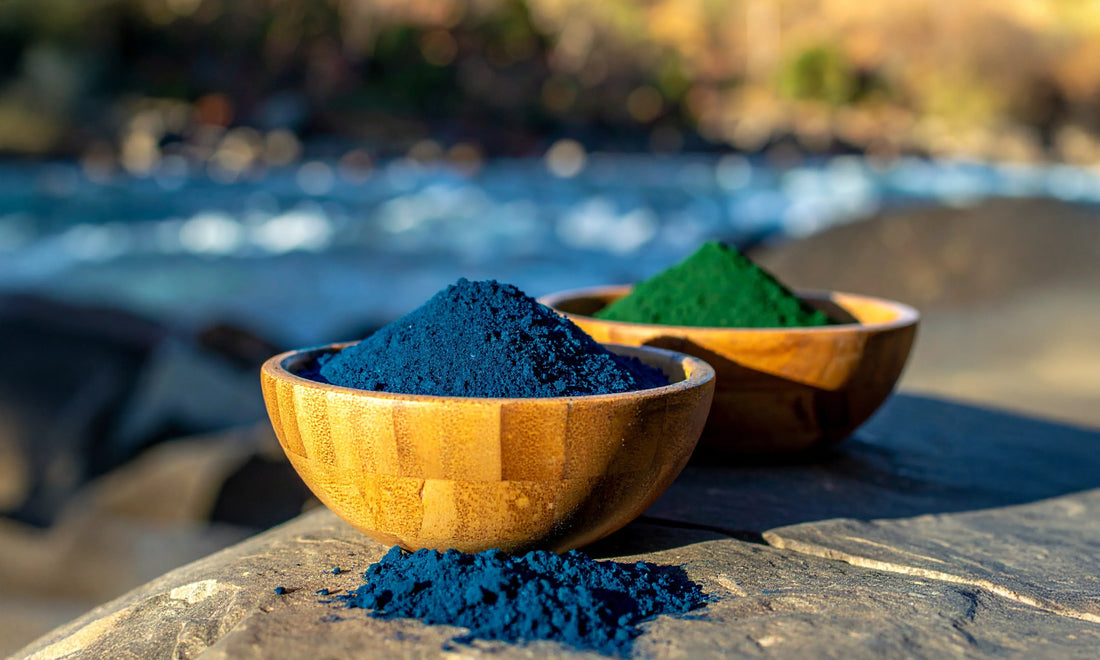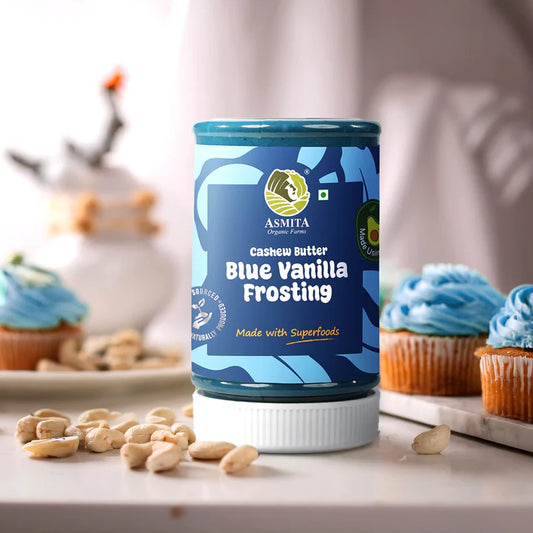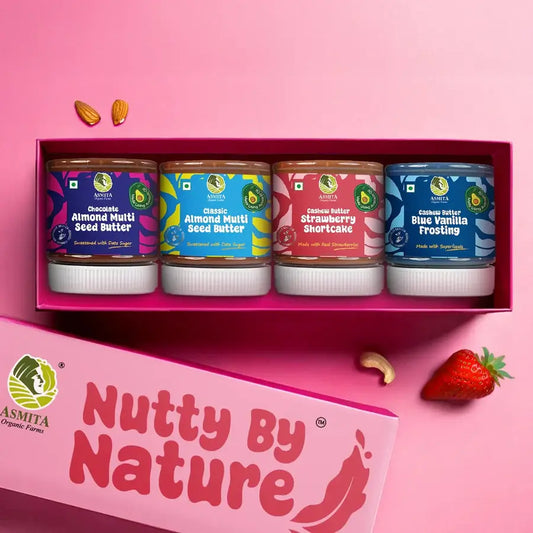Blue vs Green Spirulina – What’s the Difference?
5 min read
Spirulina has become a popular addition to many people’s wellness habits. Found in smoothies, supplements, and energy bars, this nutrient-dense algae has made its way into daily routines.
While looking into spirulina products, you might have noticed they mostly come in two colours: blue and green. If you think, despite the colour difference, both Spirulina are the same and can be used as a substitute, you couldn't be more wrong.
To understand the full picture, let’s explore how blue vs green spirulina vary, what gives them their colours, and how to decide which one works best for you.
Table of Contents
1. What is Spirulina?
2. What Makes Spirulina Blue?
3. What Makes Spirulina Green?
4. Nutritional Differences Between Blue & Green Spirulina
5. Which One Tastes Better?
6. When Should You Use: Blue or Green?
7. How to Choose a Quality Spirulina Product
8. Where to Buy
9. Bottom Line
What is Spirulina?
Spirulina is a natural algae superfood that grows in both fresh and salt water. It is one of the oldest life forms on Earth and has been used for its nutritional properties across different cultures.
What makes it stand out is its high protein content, along with important vitamins, minerals, and antioxidants. Today, it is often sold as powder, capsules, or tablets and added to smoothies and juices for a concentrated health boost.
What Makes Spirulina Blue?
Blue spirulina is made by extracting a single compound from green spirulina. That compound is called phycocyanin, which is responsible for its intense blue colour. This extract contains high levels of antioxidants and anti-inflammatory agents.
Since it goes through an extra filtration process, blue spirulina does not include chlorophyll or the other parts of the algae. The result is a more concentrated source of phycocyanin benefits, often preferred for its smooth texture and mild taste. It blends easily into drinks and gives them a striking blue shade without the ocean-like flavour.
What Makes Spirulina Green?
The classic green spirulina is made from the entire spirulina biomass. It is dried and ground without removing any part of the algae, which keeps all the pigments and nutrients intact.
The green colour comes mainly from chlorophyll, a powerful antioxidant that supports detoxification, immune health, and even clearer skin. It also contains phycocyanin, though in a lower concentration compared to the blue version.
Because it uses the whole algae, green spirulina has a strong, earthy taste that some people find bold or grassy.
Nutritional Differences Between Blue & Green Spirulina
When it comes to the nutrition profile, both types offer health benefits in their own way. This kind of spirulina comparison is helpful if you’re deciding which one better supports your goals.
Here’s a nutrition profile difference table for blue vs green spirulina:
|
Nutrient/Benefit |
Green Spirulina |
Blue Spirulina |
|
Form |
Whole algae |
Phycocyanin extract |
|
Protein |
High |
Moderate |
|
Iron & B Vitamins |
Present in significant amounts |
Minimal due to extraction |
|
Minerals (Magnesium, Potassium) |
Rich in essential minerals |
May be reduced during processing |
|
Chlorophyll |
Abundant, supports detox and immune function |
Removed during extraction |
|
Phycocyanin |
Present, but in lower concentration |
High concentration supports inflammation reduction and cell protection |
|
Enzymes & Fatty Acids |
Naturally present |
Not retained |
|
Best For |
Full-spectrum nutrition, energy, immunity, detox |
Antioxidant support, brain health, vibrant appearance in food and drinks |
Which One Tastes Better?
Taste plays a big role when deciding between blue vs green spirulina. Green spirulina has a deep, earthy flavour with a slightly salty, sea-like edge. It pairs well with strong fruits like pineapple or citrus in smoothies, but for some people, the taste can be overpowering on its own.
Blue spirulina is much milder. Since it is made from an extract and doesn’t contain the full algae, the taste is smoother and almost neutral. This makes it easier to blend into drinks, smoothie bowls, or desserts without changing the flavour much. If you’re new to spirulina or picky about taste, blue spirulina might be easier to enjoy.
When Should You Use: Blue or Green?
The choice between blue vs green spirulina depends on what you’re aiming for. Green spirulina works well as a daily supplement if you're looking for a complete source of nutrition and do not mind a stronger flavour. It supports digestion, boosts energy, and adds plant-based protein to your diet.
Blue spirulina is often the pick for visual appeal and a milder taste. It blends easily into smoothies, lattes, and desserts without overpowering other flavours. With its high concentration of phycocyanin, it’s ideal for an antioxidant boost and light, refreshing recipes.
Some people keep both on hand and use them based on their needs or recipes. This way, you can enjoy variety in both taste and benefits without missing out.
How to Choose a Quality Spirulina Product
Once you’ve decided between blue spirulina powder vs green spirulina, the next step is making sure you’re getting a product that’s actually worth your money. Not all spirulina is created the same, and the way it’s grown and processed can affect both its safety and its nutritional value.
A few simple checks can help you avoid poor-quality options and choose something clean, effective, and trustworthy. Here’s what to look for when buying spirulina:
- Source transparency – Choose brands that clearly share where and how their spirulina is grown.
- Clean cultivation – Look for spirulina grown in controlled environments with no exposure to harmful chemicals.
- Low-heat drying – This helps preserve the full nutrition profile without damaging heat-sensitive nutrients.
- No additives or fillers – A quality spirulina product should contain only one ingredient: 100% spirulina.
- Certified organic – Organic spirulina is grown without synthetic fertilisers, pesticides, or heavy metals.
- Third-party lab testing – This confirms the product’s purity, safety, and phycocyanin benefits content.
- Proper packaging – Spirulina should be packed in airtight containers that protect it from light, heat, and moisture.
Where to Buy
If you’re looking for high-quality, clean, and nutrient-rich spirulina, check out AsmitA Organic Farms’ Cashew Butter – Blue Vanilla Frosting.
This bright blue beauty is India’s first blue nut butter, with zero palm oil, preservatives, dairy, gluten, or soy. It’s a clean, creamy spread made from roasted cashews, extra-virgin avocado oil, monk fruit, natural vanilla extract, and of course, blue spirulina—the very same phycocyanin-packed superfood we’ve been talking about.

Bottom Line
So, when it comes to blue vs green spirulina, there’s no one-size-fits-all answer. Green spirulina is like your full-meal deal: earthy, bold, and loaded with all the goodness from the whole algae.
But if you’re new to the spirulina scene or just prefer something light and easy to blend into your smoothies, lattes, or desserts, blue’s your hue. And that’s exactly where AsmitA Organic Farms shines.
We’re proud to offer premium-quality, delicious innovations like our Blue Vanilla Frosting Cashew Butter, a first-of-its-kind nut butter that turns health food into a little jar of joy. Shop now and taste the difference!





